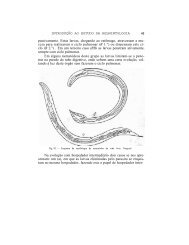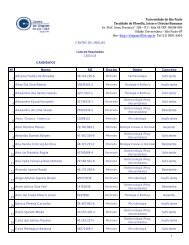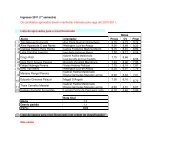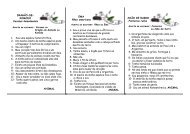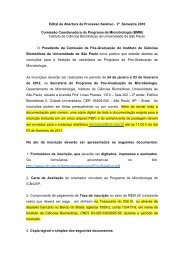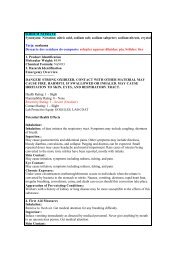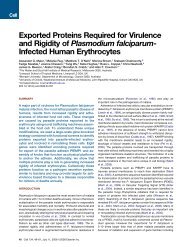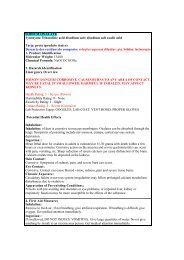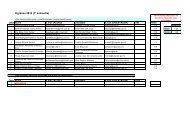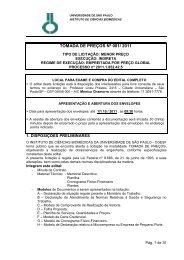SODIUM BISU LFITE Synonyms: Sodium acid sulfite ... - USP
SODIUM BISU LFITE Synonyms: Sodium acid sulfite ... - USP
SODIUM BISU LFITE Synonyms: Sodium acid sulfite ... - USP
- No tags were found...
Create successful ePaper yourself
Turn your PDF publications into a flip-book with our unique Google optimized e-Paper software.
<strong>SODIUM</strong> <strong>BISU</strong> <strong>LFITE</strong><strong>Synonyms</strong>: <strong>Sodium</strong> <strong>acid</strong> <strong>sulfite</strong>; Sulfurous <strong>acid</strong>, monosodium salt; <strong>Sodium</strong> hydrogen<strong>sulfite</strong>, solidTarja: nenhumaDescarte dos resíduos do composto: soluções aquosas diluídas: pia. Sólidos: lixo1. Product IdentificationMolecular Weight: 104.06Chemical Formula: A mixture of NaHSO3 (sodium bi<strong>sulfite</strong>) and Na2S2O5 (sodiummetabi<strong>sulfite</strong>)3. Hazards IdentificationEmergency Overview--------------------------WARNING! HARMFUL IF SWALLOWED OR INHALED. MAY CAUSE ALLERGICRESPIRATORY REACTION. CAUSES IRRITATION TO SKIN, EYES ANDRESPIRATORY TRACT. REACTS WITH ACIDS AND WATER RELEASINGTOXIC SULFUR DIOXIDE GAS.Health Rating: 2 - ModerateFlammability Rating: 0 - NoneReactivity Rating: 1 - SlightContact Rating: 1 - SlightLab Protective Equip: GOGGLES; LAB COATPotential Health EffectsInhalation::Causes irritation to the respiratory tract. Symptoms may include coughing, shortness of breath.May cause allergic reaction in sensitive individuals.Ingestion::May cause gastric irritation by the liberation of sulfurous <strong>acid</strong>. An asthmatic reaction mayoccur after Ingestion:. Large doses may result in nausea, vomiting, diarrhea, abdominal pains,circulatory disturbance, and central nervous system depression. Estimated fatal dose is 10 gm.Skin Contact:Causes irritation to skin. Symptoms include redness, itching, and pain.Eye Contact:Causes irritation, redness, and pain. Contact may cause irreversible eye damage. Symptomsmay include stinging, tearing, redness, swelling, corneal damage and blindness.Chronic Exposure:No information found.Aggravation of Pre-existing Conditions:Some individuals are said to be dangerously sensitive to minute amounts of <strong>sulfite</strong>s in foods.Symptoms may include broncho constriction, shock, gastrointestina l disturbances, angioedema, flushing, and tingling sensations. Once allergy develops, future exposures can causeasthma attacks with shortness of breath, wheezing, and cough.4. First Aid MeasuresInhalation::Remove to fresh air. If not breathing, give artificial respiration. If breathing is difficult, giveoxygen. Get medical attention.Ingestion::Induce vomiting immediately as directed by medical personnel. Never give anything by mouthto an unconscious person. Get medical attention.Skin Contact:
Skin Contact:Wipe off excess material from skin then immediately flush skin with plenty of water for atleast 15 minutes. Remove contaminated Clothing and shoes. Get medical attention. WashClothing before reuse. Thoroughly clean shoes before reuse.Eye Contact:Immediately flush eyes with plenty of water for at least 15 minutes, lifting lower and uppereyelids occasionally. Get medical attention immediately.5. Fire Fighting MeasuresFire:Not considered to be a fire hazard.Explosion:Not considered to be an explosion hazard.Fire Extinguishing Media:Use any means suitable for extinguishing surrounding fire. Do not allow water runoff to entersewers or waterways.Special Information:In the event of a fire, wear full protective Clothing and NIOSH-approved self-containedbreathing apparatus with full facepiece operated in the pressure demand or other positivepressure mode.6. Accidental Release MeasuresVentilate area of leak or spill. Wear appropriate personal protective equipment as specified inSection 8. Spills: Pick up and place in a suitable container for reclamation or disposal, using amethod that does not generate dust. Cautiously spray residue with plenty of water, providingventilation to clear sulfur dioxide fumes generated from water contact. US Regulations(CERCLA) require reporting spills and releases to soil, water and air in excess of reportablequantities. The toll free number for the US Coast Guard National Response Center is (800)424-8802.7. Handling: and StorageKeep in a tightly closed container. Protect from physical damage. Store in a cool, dry,ventilated area away from sources of heat, moisture and incompatibilities. Releases toxicsulfur dioxide gas when in contact with water, ice. Containers of this material may behazardous when empty since they retain product residues (dust, solids); observe all warningsand precautions listed for the product.8. Exposure Controls/Personal ProtectionAirborne Exposure Limits:-ACGIH Threshold Limit Value (TLV):5mg/m3 (TWA) for sodium bi<strong>sulfite</strong> & for sodium metabi<strong>sulfite</strong>, A4 Not classifiable as ahuman carcinogen.Ventilation System:A system of local and/or general exhaust is recommended to keep employee exposures belowthe Airborne Exposure Limits. Local exhaust ventilation is generally preferred because it cancontrol the emissions of the contaminant at its source, preventing dispersion of it into thegeneral work area. Please refer to the ACGIH document, Industrial Ventilation, A Manual ofRecommended Practices, most recent edition, for details.Personal Respirators (NIOSH Approved):If the exposure limit is exceeded and engineering controls are not feasible, a half-facerespirator with an <strong>acid</strong> gas cartridge may be worn for up to ten times the exposure limit or themaximum use concentration specified by the appropriate regulatory agency or respiratorsupplier, whichever is lowest. A full-face piece respirator with an <strong>acid</strong> gas cartridge may beworn up to 50 times the exposure limit, or the maximum use concentration specified by theappropriate regulatory agency, or respirator supplier, whichever is lowest. For emergencies or
appropriate regulatory agency, or respirator supplier, whichever is lowest. For emergencies orinstances where the exposure levels are not known, use a full-facepiece positive-pressure, airsuppliedrespirator. WARNING: Air-purifying Respirators do not protect workers in oxygendeficientatmospheres.Skin Protection:Wear impervious protective Clothing, including boots, gloves, lab coat, apron or coveralls, asappropriate, to prevent skin contact.Eye Protection:Use chemical safety goggles. Maintain eye wash fountain and quick-drench facilities in workarea.9. Physical and Chemical PropertiesAppearance: Coarse white granules.Odor: Slight odor of sulfur dioxide.Solubility: Very soluble in water, insoluble in alcohol.Specific Gravity: 1.48Melting Point: 150C (302F)10. Stability and ReactivityStability:Strength diminishes somewhat with age. Gradually decomposes in air to sulfate, generatingsulfurous <strong>acid</strong> gas. Contact with moisture (water, wet ice, etc.), will release toxic sulfurdioxide gas.Hazardous Decomposition Products:Burning may produce sulfur oxides.Hazardous Polymerization:Will not occur.Incompatibilities:Water, <strong>acid</strong>s, alkalis, sodium nitrite, oxidizers, aluminum powder.Conditions to Avoid:Moisture, heat, flames, ignition sources and incompatibles.11. Toxicological Information<strong>Sodium</strong> Metabi<strong>sulfite</strong> [7681-57-4]: No LD50/LC50 information found relating to normalroutes of occupational exposure. Investigated as a tumorigen, mutagen and reproductiveeffector. <strong>Sodium</strong> Bi<strong>sulfite</strong> [7631-90-5]: Oral rat LD50: 2000 mg/kg. Investigated as atumorigen and mutagen.--------\Cancer Lists\---------------------------------------------------------NTP Carcinogen---Ingredient Known Anticipated IARC Category------------------------------------ ----- ----------- -------------<strong>Sodium</strong> Bi<strong>sulfite</strong> (7631-90-5) No No 3<strong>Sodium</strong> Metabi<strong>sulfite</strong> (7681-57-4) No No 3



